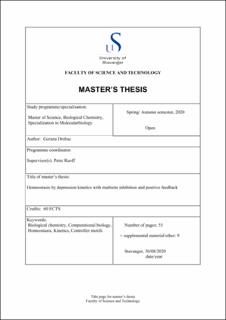| dc.contributor.advisor | Ruoff, Peter | |
| dc.contributor.author | Drobac, Gorana | |
| dc.date.accessioned | 2021-01-28T09:45:34Z | |
| dc.date.available | 2021-01-28T09:45:34Z | |
| dc.date.issued | 2020 | |
| dc.identifier.uri | https://hdl.handle.net/11250/2725124 | |
| dc.description | Master's thesis in Biological chemistry | en_US |
| dc.description.abstract | In order to survive all living organisms must, to some extent, be able to adapt to the changes in environment.In recent years there have been proposed different controller motifs that are used to explain how does the organisms achieve robust homeostasis. The most of the proposed controller motifs reach the limit when the perturbations become time dependent. Motifs based on depression kinetics have shown ability to keep up with the even exponential and hyperbolic change in perturbation. The only unfavorable with these controllers is that they tend to break down when the concentration of the regulatory inhibitor becomes too low and the compensatory flux has reached its maximum. So, in order to circumvent this disadvantage we have included a multisite inhibition and positive feedback mechanism.
We have as well taken the time to test other abilities of the newly composed controller and showed that it can become oscillatory and still preserve the homeostasis by keeping the average concentration of controlled variable at the defined level. | en_US |
| dc.language.iso | eng | en_US |
| dc.publisher | University of Stavanger, Norway | en_US |
| dc.relation.ispartofseries | Masteroppgave/UIS-TN-IKBM/2020; | |
| dc.subject | biologisk kjemi | en_US |
| dc.subject | biochemistry | en_US |
| dc.title | Homeostasis by depression kinetics with multisite inhibition and positive feedback | en_US |
| dc.type | Master thesis | en_US |
| dc.subject.nsi | VDP::Matematikk og Naturvitenskap: 400::Basale biofag: 470::Biokjemi: 476 | en_US |
